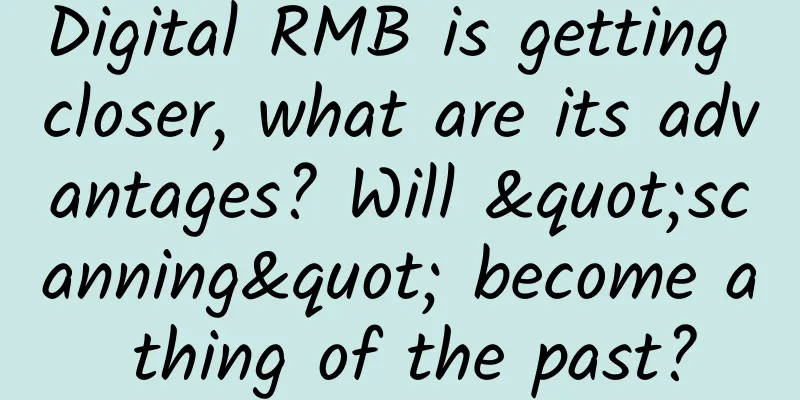Digital RMB is getting closer, what are its advantages? Will "scanning" become a thing of the past?

|
With the popularity of smart phones, it has become common to use mobile phones to make various payments. However, the rise of mobile payments is bound to affect the liquidity of cash. I wonder how many people still keep the habit of paying in cash? Now, not only in China, but also in many countries around the world, the use of cash is getting lower and lower. According to data from the Norwegian Central Bank, the current cash use rate in Norway is only 3%-4%. According to a McKinsey report, Norway is already the country with the lowest cash use rate in the world. Apart from Norway, China's current cash use rate is not very high, which can be seen from the proportion of mobile payments.
Why do people like to use mobile payment? It's simple, because mobile payment caters to the current busy pace of life of ordinary people. If you use cash, you have to wait for change or face the "dilemma" of not bringing enough cash. However, using mobile payment is very convenient. Just "scan" and you can easily complete the payment. Even if the wallet balance is insufficient, there are other overdraft software to pay.
Thanks to hundreds of millions of mobile payment users, the central bank said that as of the end of December 2020, the total amount of mobile payment business was 432.16 trillion yuan, and it is expected to exceed 100 trillion yuan by 2025. However, although "scan" is very convenient, another payment method has recently entered the sight of ordinary people, that is, "touch and pay". Where can “digital RMB” be used? With the acceleration of digital transformation, the pilot process of digital RMB is also accelerating. In 2019, only a few places in the country launched pilot work, but by July 2021, digital RMB can be used for various payments in many places across the country. Among them, Hainan Province, as a pilot province for the application of digital RMB in the province, completed the province's first payment activity for the purchase of new energy vehicles using digital RMB on October 21, 2021.
In other provinces and cities, it can also be used to scan cars, take the subway, pay provident funds or pay employee wages. The governor of the central bank stated at the G30 meeting that the current main use of the digital RMB is to meet various retail payments. However, in the future, cross-border use will be further developed. The digital RMB is like the balance we have in our bank card or WeChat wallet, except that payment can be completed directly without going through third-party software. The international name of the digital RMB is "e-CNY", which is the "electronic version" of the RMB and has the same legal tender function as cash. Although the central bank has not yet given accurate information on the full implementation of the digital RMB, judging from the current level of domestic pilot projects, it should not be far from full popularization. Moreover, in the "White Paper" released by the central bank, as of June 2021, the number of whitelist users has exceeded 10 million.
Will “Scan” become a thing of the past? As the pilot work progresses, the use of digital RMB is becoming more and more widespread. In response, many people have "abandoned" their original WeChat or Alipay and turned to the "embrace" of digital RMB. I believe many people are curious, since they are all payment software, what are the advantages of digital RMB? First of all, the digital RMB does not rely on the Internet. Unlike WeChat and Alipay, you must have an Internet connection to scan the code to pay or complete the transfer. Moreover, in third-party payment software, although recharge does not require a fee, withdrawals do require a fee. If the withdrawal is a large amount, the fee is quite high.
However, for the digital RMB, poor network or no network will not affect the payment status. Payment can be completed offline, and even withdrawals do not require payment of handling fees. Secondly, the digital RMB is not a virtual currency that exists in a virtual wallet, but a national legal currency. The probability of criminals wanting to "steal" or "defraud" by various means is very low. Moreover, the digital RMB also has an "anonymity" function, which can protect the user's security and privacy to the greatest extent.
Finally, the payment method of the digital RMB is “touch and pay”. You only need to touch the mobile phone and the device to complete the payment. It has to be said that this payment method is more time-saving and labor-saving than “scanning”. Some people say that after the full popularization of digital RMB in the future, it may bring an impact to "scanning", and scanning will become a thing of the past. In fact, this statement is not impossible. After all, the high security factor, offline payment and high traceability make digital RMB have multiple guarantees. It is worth mentioning that on October 22, 2021, the deputy director of the Financial Research Institute of the People’s Bank of China stated that the full-scenario coverage of the digital RMB will be further accelerated in the future. Maybe we won’t have to wait too long before everyone can use the digital RMB. Are you looking forward to this? If it were you, would you choose digital RMB, WeChat or Alipay? |
<<: iOS/iPad OS 14.8.1 released: Apple recommends upgrading all older iPhone models
>>: As smartphones have developed to this day, I increasingly want to go back to the Nokia era
Recommend
What are the promotion strategies used by platforms such as Tencent, Baidu, and Bytedance?
What trends are shown in advertising placement on...
Tobacco is sweet? Diabetes warning!
Author: Xiao Dan, Director of the Department of T...
Best Android Hacking Tools of 2016
This list is for educational purposes only. To le...
What is the billing method for Weibo Fans Pass? How to place Weibo Fans Ads?
1. Weibo Fans Pass Billing Method 1. Real-time bi...
Good news for wound healing: snails on French tables are not only delicious but also useful!
Produced by: Science Popularization China Author:...
3 strategies for native advertising!
Only by using fewer "tricks" can you tr...
8 methods of APP promotion and marketing!
The eight golden rules introduced in this article...
"Not being able to distinguish between left and right rotations" may be fatal. The Nobel Prize in Chemistry has solved a "thorny" medical problem
In the early 1960s, a notorious drug safety incid...
"Happy Candy Crush" APP Operation Analysis
Happy Match 3 is a strategy game developed by Ten...
On World Wildlife Day, let’s get to know them and fall in love with them!
Are giant pandas really iron-eating animals? Is t...
ESA sent a glass of "juice" to Jupiter, or will it reveal the mystery of the "ice moon" there?
Jupiter is the largest planet in the solar system...
A brief history of operations: 20 years of development and evolution of Internet operations (continued)
(Continued from the previous article) 2009-2013: ...
A textbook on escaping danger during the 5.1 magnitude earthquake in Yibin, Sichuan
At 07:50 on April 6, 2022, a magnitude 5.1 earthq...
In the next three days, these areas will be cloudy and rainy! Please check this rainy day safety travel guide →
The Central Meteorological Observatory predicts t...
Langji Education Dayao "Jane Eyre" video course
Dayao's Jane Eyre introduction: The appeal of...









